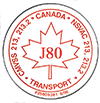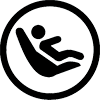Using a child car seat correctly means you’re taking one of the best steps to protect your child in a crash.
Buying
- Check the expiry date before you buy. Most seats are stamped with the expiry date on the back or bottom of the seat. If you can’t find the date, contact the car seat manufacturer or see Transport Canada’s dedicated page.
- Buy your car seat in Canada to ensure it meets Canada’s Motor Vehicle Safety Standards. Car seats purchased online may not meet Canadian Safety Standards. Look for the National Safety mark!

- Check if the car seat has been recalled on Transport Canada’s website at tc.gc.ca.
- Follow the installation instructions the manufacturer provides with your car seat.
- Child car seats and booster seats are exempt from provincial sales tax.
Installing
The Universal Anchorage System (UAS) is a standardized system that can make installing child seats easier. All Canadian infant and child car seats manufactured on or after Sept. 1, 2002 have two connectors that attach to the vehicle’s anchorage bars. You can install your car seat with the UAS or the seatbelt, as long as it has a lap and shoulder belt. The seatbelt and UAS cannot be used together.
Some vehicles also have the center-seat fitted with UAS anchor bars. In a van that has more than two rows of seats there will be two locations for the UAS, one of which will be in the second row of seats.

Look for this symbol on the infant and child seats as well as on the vehicle seats. Check your vehicle owner’s manual to find out where your UAS anchors are located.
A top tether strap must be used on all forward facing child seats, regardless of whether it is secured by a UAS or a seatbelt.
Stages
Car seats are designed to meet the safety needs of where your child is in their development. If you’re unsure if your child needs a rear-facing, forward-facing or booster seat, visit our ‘child car seat stages’ page.
Replacing
Replace any car seat that was involved in a moderate or serious collision. The impact can cause damage to the seat, whether it was occupied or not. The seat may not provide adequate protection in a future collision.
If your car or booster seat has been involved in a collision, follow these steps.
Customers can safely dispose of an expired car or booster seat that hasn’t been involved in a collision at the following locations:
- In Winnipeg, visit the Physical Damage Centre, located at 1981 Plessis Road, Building C, Security.
- Outside Winnipeg, visit your nearest MPI Service Centre.
For more information please contact Community Relations:
In Winnipeg: 204-985-8737
Outside Winnipeg: 1-888-767-7640
Book a community presentation
To book a presentation on child car seats for your community group, school or business, visit our Road Safety Community Presentations page for more information. For newcomers to Manitoba and newcomer organizations, an adapted “Welcome to Manitoba” presentation with child car seat information included is available.